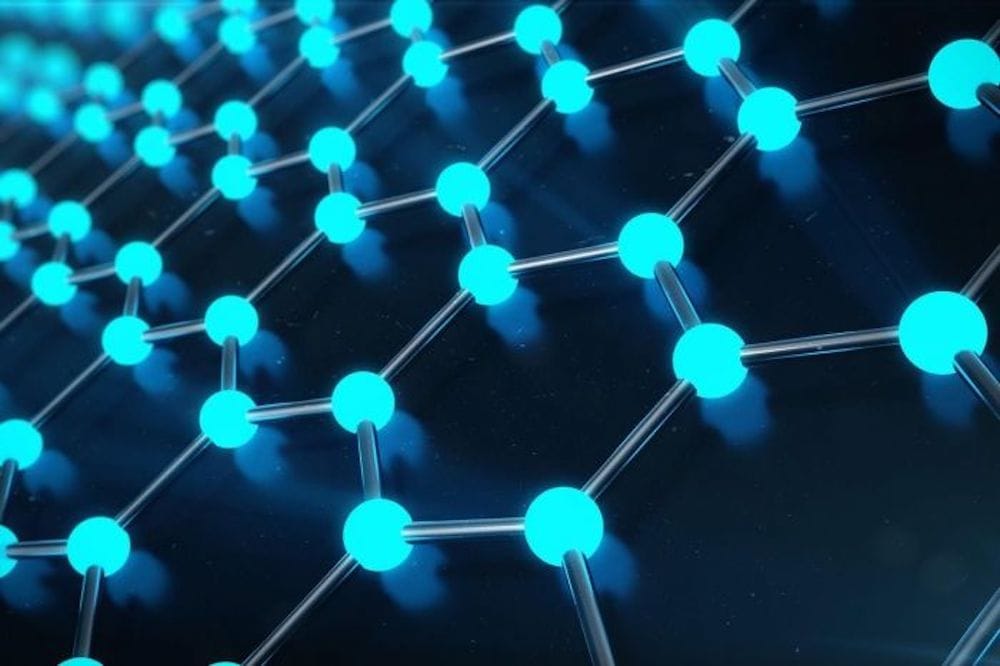
[Image above] Graphene is a well-studied material, but what do we know about its melting curve? Credit: Moscow Institute of Physics and Technology
Last Friday, we learned that tungsten could replace carbon materials in tokamaks because tungsten is less reactive with tokamak fuel. However, researchers had a good reason for using carbon materials when originally designing tokamaks—carbon is extremely heat resistant, providing good protection again plasma.
Just how heat resistant is carbon? Perhaps surprisingly, we do not know for sure.
Researchers have struggled to create an accurate phase diagram of carbon for more than 100 years, at least since Watts and Mendenhall investigated the behavior of graphite at high temperatures in 1911. The melting curve of the phase diagram in particular drives contention.
A melting curve (also called melting line) is the curve on a phase diagram that represents the transition between solid and liquid states. Since at least 1963, researchers have carried out numerous experimental attempts to evaluate the melting curve of graphite, but these experiments give very different melting points—estimates of the melting temperature of graphite range from about 4,000 K (6,740°F) to 5,000 K (8,540°F).
Another part of the melting curve under question is the existence of a melting curve maximum.
A melting curve maximum represents the point at which melting temperature and pressure go from a positive relationship (melting temperature increases with pressure) to a negative relationship (melting temperature decreases with increasing pressure).
“Some of the studies confirm the presence of the maximum on the melting curve, while others do not,” Yu D. Fomin, researcher at the Moscow Institute of Physics (MIPT), says in an email. “Indeed, even the works confirming the presence of maximum claim that the maximum is small and can be within the uncertainty of the experiments. Because of this the existence or non-existence of the maximum is still under question.”
If the maximum does exist, however, what causes it to appear?
In 1967, Eliezer Rapoport proposed a model to explain melting curve maxima. It says a liquid-liquid phase transition (LLPT) takes place at that point, a transition from a low-density liquid structure to a high-density liquid structure.
An early simulation paper on carbon melting published in 1999 suggested that carbon exhibits an LLPT, but succeeding empirical and ab initio simulations discounted this prediction. As such, the cause of a carbon melting curve maximum is still unclear.
The numerous contentions concerning the melting curve of carbon present considerable opportunities for researchers to explore these questions. And that opportunity was recently embraced wholeheartedly by Fomin and Vadim V. Brazhkin, researcher at the Institute of High Pressure Physics Russian Academy of Sciences.
They used the empirical AIREBO model and ab initio simulations to try answering some of these questions on carbon melting. They compared their results with prior experimental and theoretical data and came to several main conclusions.
Existing models are highly inaccurate
Some empirical models (AIREBO, Tersoff potential, Brenner potential) are fitted to experimental data on carbon and hydrocarbons at low temperatures. Thus, “These models fail to reproduce the structure of liquid carbon above the melting line” and “do not describe the melting line of graphite properly.”
A melting curve maximum should exist—and it is caused by a smooth structural crossover
In an email, Fomin says their results state the maximum should exist—but it is not caused by LLPT.
Both AIREBO and ab initio simulations showed an unusual dependence of position and height of the first maximum of the radial distribution function, i.e., a function that describes the structure of the liquid.
“This circumstance means that a smooth structural crossover occurs in liquid carbon,” the researchers write.
A smooth structural crossover, unlike “real” LLPT, does not include a density jump but rather smoothly changes from one structure to another. This crossover, according to the researchers, can explain the melting curve maximum.
Graphene “melting” is actually sublimation
Data from previous computer modeling studies showed a “collapse” of graphene into a phase composed of linear chains at high temperatures (4,500–4,900 K).
“For this reason, both groups that performed LCBOPII and AIREBO simulations claim that this process is some kind of a polymerization process or, probably, the formation of carbine rather than real melting. However, they propose to remain the term melting for simplicity,” the researchers explain in the paper.
After running their own study, the researchers state that this collapse is due to sublimation (a transition directly from solid to gas) rather than melting.
Correcting for more accurate simulations
Although identifying the graphene “collapse” as sublimation rather than melting helps paint a clearer picture of what happens to carbon at high temperatures, the researchers say the suggested temperatures for sublimation do not make sense.
“Since the melting temperatures of [carbon] systems do not depend on the pressure, one should conclude that the temperature of the triple point should be the same as the melting temperature of graphite (Tt = 3640 K for AIREBO and Tt = 4250 K for LCBOPII),” the researchers write. “The ‘melting’ (sublimation) points of graphene are Tm = 4900 K for AIREBO and Tm = 4510 K for LCBOPII. These sublimation temperatures are above the temperatures of the triple point of graphite, which does not make sense.”
“This observation means that sophisticated analysis of the simulation data is required to make any conclusions on the melting or sublimation temperature of graphite or graphene,” the researchers add.
With these difficulties in mind, the researchers ran a simulation of graphene melting in an argon atmosphere and found the melting temperature obtained in their simulation agreed with the melting temperature of graphite obtained with the same model. However, because of graphene’s two-dimensional nature and the fact that carbon-argon interactions can affect decomposition, “the temperature obtained in our simulations is not an exact melting temperature of pure graphene.”
“Some further corrections are required to obtain the genuine melting temperature of graphene,” they conclude.
In an email, Fomin says they will extend this work on graphene melting to investigate melting properties of similar substances, namely silicene and germanene. Additionally, they are working on understanding the melting properties of colloidal crystals and the melting of rare gases confined into a slit pore.
The paper, published in Carbon, is “Comparative study of melting of graphite and graphene” (DOI: 10.1016/j.carbon.2019.10.065).
Author
Lisa McDonald
CTT Categories
- Basic Science
- Modeling & Simulation
Related Posts
‘Fairy circles’ may help mark natural underground hydrogen deposits
September 18, 2025


